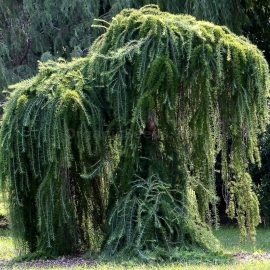
Organic Japanese Larch Seeds (Larix kaempferi)
1.14 €
Japanese Larch is a medium-sized to large deciduous coniferous tree native to Japan, reaching 20–40 m tall, with a trunk up to 1 m diameter. The crown is broad conic; both the main branches and the side branches are level.
-
Organic Japanese Larch (Larix kaempferi)
Japanese Larch is a medium-sized to large deciduous coniferous tree native to Japan, reaching 20–40 m tall, with a trunk up to 1 m diameter.
The crown is broad conic; both the main branches and the side branches are level, the side branches only rarely drooping. The needles are a light glaucous green through the spring and summer turning bright yellow to orange before they fall in the autumn, leaving the pinkish-brown shoots bare until the next spring.
Prefers to grow in an open airy position and can become very vigorous making between 1 and 1.5 metres (3-5ft) increase in height per year
Japanese Larch is an important forestry tree in its native country and also widely planted in northern Europe, particularly the British Isles. Grows best on well-drained soils, avoiding waterlogged ground.
The wood is tough and durable, used for general construction work. Small larch poles are widely used for rustic fencing. It is a very hardy tree and is not frost tender.
For germination the seeds require a period of moist pre-chilling also known as stratification before the seeds should be sown, this takes around 6 weeks in the fridge and is not difficult to do!
How to Grow
Japanese Larch seeds are relatively easy to germinate and grow. The dormancy within the seed is short and easily broken. This is achieved by a short period of stratification which usually needs to be done in a fridge.
First soak the seeds in water for 24 hours, then fully drain away all of the water and place the seeds in a zip-lock freezer bag. Place the seeds in the fridge at around 4 Celsius, it is important that during this period that the seeds do not dry out or are waterlogged otherwise the pre-treatment will be ineffective.
After 6 weeks under these conditions the seeds are ready to be sown. In general, the seeds will fail to germinate unless treated in this way, simply sowing untreated seeds in compost at room temperature will not break down the dormancy and germination will be disappointing. Depending on different seed-lots it is possible that germination may begin before the end of pre-treatment, if this happens sow all of the seeds quickly!
Fill your chosen container with a good quality general potting compost. Suitable containers could be plant pots, seed trays or plug trays or even improvised containers with drainage holes. Firm the compost gently and sow the seeds on the surface. If you are sowing in plug trays, sow 2 or 3 seeds per cell.
Cover the seeds with a couple of millimeters of vermiculite or failing that a fine layer of sieved compost.
Follow with a gentle watering and keep them at room temperature. Germination will begin a few weeks from sowing. The seedlings are reasonably robust and trouble free and usually grow to a height of between 10 and 20 cm in the first growing season depending on the sowing date and cultural techniques.
Densely sown seedlings are at risk from fungal diseases such as “damping off” which can cause rapid loss of many seedlings.
Developing seedlings should be fine in full sun, keep them well watered and free of competing weeds. Growth will accelerate in the second and subsequent years and the developing young trees should be re-potted as necessary preferably during the dormant season. After perhaps 2 years they are ready to be planted in their permanent position.
How to grow Conifers from seeds
